| Pages:
1
2
3
4
5
6
..
16 |
Druïdecook
Harmless

Posts: 13
Registered: 12-3-2016
Member Is Offline
Mood: No Mood
|
|
Mystery glassware
Hello,
I recently bought some glassware of an auction site.
That's how i becam owner of some glass pieces wich have application's that'aren't 100% known to me. Maybe you guys can give me some hints.
The auction also contained a bunch of LARGE glass pieces wich can be connected to form a distillation/rectification unit. Maybe you guys can giive me
hints whats missing and what's not part of the unit. Or should i open an new subject on this?
sorry for my bad English
Greets
Photo's mystery glass attached.
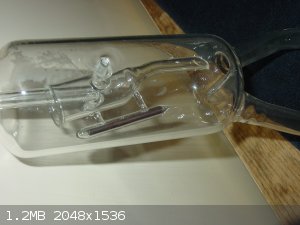 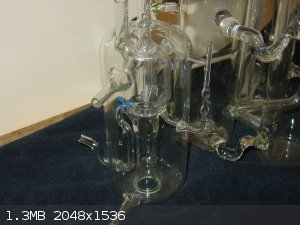 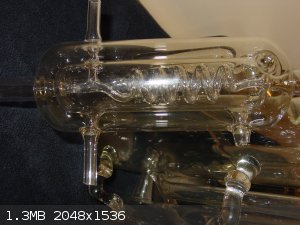 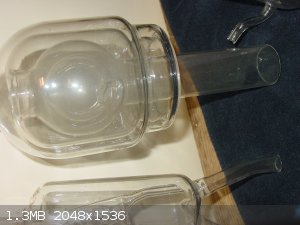 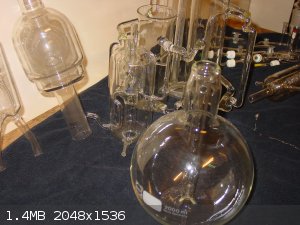 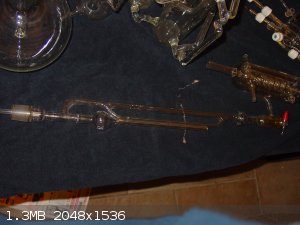 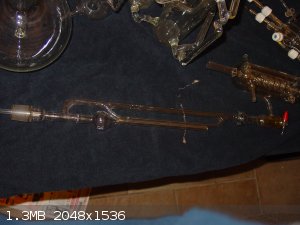 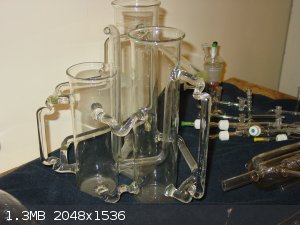 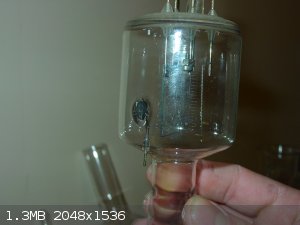 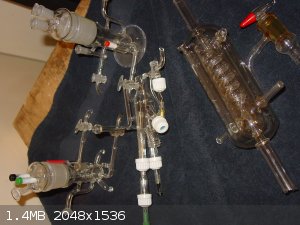
|
|
|
Druïdecook
Harmless

Posts: 13
Registered: 12-3-2016
Member Is Offline
Mood: No Mood
|
|
Some have broken inled's / outled's or something like that
|
|
|
j_sum1
Administrator
       
Posts: 6373
Registered: 4-10-2014
Location: At home
Member Is Online
Mood: Most of the ducks are in a row
|
|
I bet it makes great coffee. 
Seriously, I have never seen anything like it.
|
|
|
Druïdecook
Harmless

Posts: 13
Registered: 12-3-2016
Member Is Offline
Mood: No Mood
|
|
The item on the second photo contains a radiation symbole so it should be used withe photo-chemistry i think.
|
|
|
Druïdecook
Harmless

Posts: 13
Registered: 12-3-2016
Member Is Offline
Mood: No Mood
|
|
Also some pics from the previously mentioned distillation glassware.
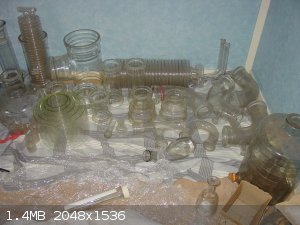 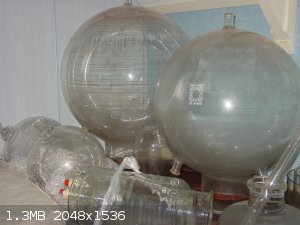 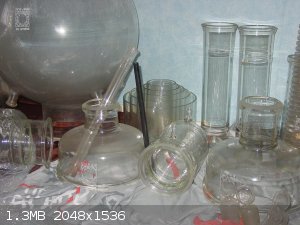 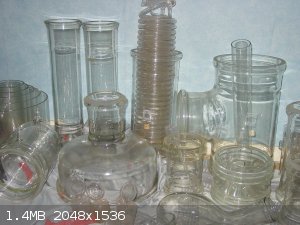 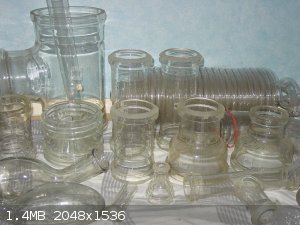 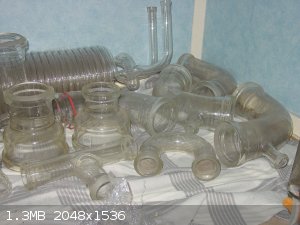 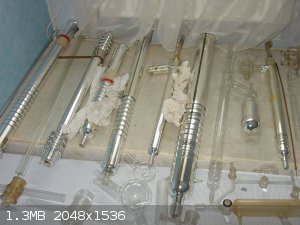 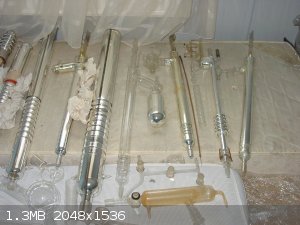 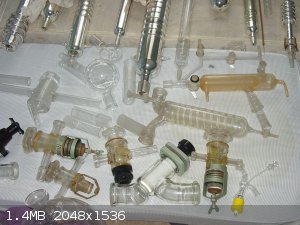 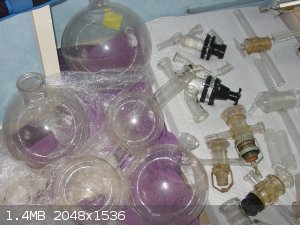
|
|
|
Texium
Administrator
       
Posts: 4665
Registered: 11-1-2014
Location: Salt Lake City
Member Is Offline
Mood: Preparing to defend myself (academically)
|
|
A lot of this stuff looks very... custom, to say the least. I bet that most of it was purpose made for a laboratory that used it for a specific
process on a relatively large scale. Those silvered tubes are very interesting. Do you have any idea what the laboratory that you got it from did?
|
|
|
Druïdecook
Harmless

Posts: 13
Registered: 12-3-2016
Member Is Offline
Mood: No Mood
|
|
It came frome a glass museum. A lot of glassware not showed is used in high vac. chemistry. Such as an Hg diffusionpomp enz.
I think some were used in the neon light manufacturing.
|
|
|
Druïdecook
Harmless

Posts: 13
Registered: 12-3-2016
Member Is Offline
Mood: No Mood
|
|
I was wondering how much of the stuff is related to each other. I know there are some missing parts (fittings , glas comp.). But I don't know for
example if the large coil is a cooling condenser or a heating coil or the small coil is also a cooling condenser or a refluxdrum heater enz..
|
|
|
Oscilllator
National Hazard
   
Posts: 659
Registered: 8-10-2012
Location: The aqueous layer
Member Is Offline
Mood: No Mood
|
|
Those ones that are silver plated may by vacuum jacketed condensers of some kind. I think they are used in very precise vacuum distillations. Perhaps
thats backed up by the other vacuum-related gear you have.
|
|
|
unionised
International Hazard
    
Posts: 5135
Registered: 1-11-2003
Location: UK
Member Is Offline
Mood: No Mood
|
|
Among other things, I think you have an ionization gauge for measuring pressure, and (in the 1st pic) a thing for collecting fractions. It looks like
you can use a magnet to change the position of the bit in the middle so it stops directing the outlet of a condenser to one pipe and directs it to
the other instead.
|
|
|
j_sum1
Administrator
       
Posts: 6373
Registered: 4-10-2014
Location: At home
Member Is Online
Mood: Most of the ducks are in a row
|
|
That first pic looks like it has some kind of metal in an ampoule on the inside of the vessel. I am wondering if it is magnetic or perhaps a
radioactive source.
The second pic has a little radiation symbol on it. That is likely a clue to deciphering its purpose.
A number of them have what looks like electrodes. Some electrochemistry perhaps? Some high-voltage sparking?
Then there is a piece that loooks like a perversion of a Dean Stark trap -- the pic that you posted twice.
Quite a few of the pieces have configurations reminiscent of a perkins triangle. And maybe for the same reason. (I forget what a Perkins triangle is
used for.)
It looks like there is more than one source of the glassware and therefore more than one particular application. I agree with Oscilllator that it
does look very custom-made for quite specific purposes. Working out which bits go with which will be a big step in figuring out what it was all used
for. Take a close look at the style of manufacture, particular markings, the way that hose-fittings, joins and welds are done. You might narrow it
down a bit.
Edit
Good thinking Unionised. That makes sense.
[Edited on 13-3-2016 by j_sum1]
|
|
|
Druïdecook
Harmless

Posts: 13
Registered: 12-3-2016
Member Is Offline
Mood: No Mood
|
|
The silvered culmns are indeed vac jacked.
Some are vigreux, oldershaw, open, vapour-liquid and a spinningband column (with inscription : patent pending nester Faust).
|
|
|
Druïdecook
Harmless

Posts: 13
Registered: 12-3-2016
Member Is Offline
Mood: No Mood
|
|
Thanx for the advices so far 
I Also think it has multiple application's. I also have a box of small glass tubing with ball-socket joints the same used in the larger glass
components. (roundbottom flasks, columns , pipes, lids, valves enz..)
Only most of the have only a ball or a socket joint.
A lot of small rotaflo high vacuum glass/teflon valves and t-connectors were included.
I think the collector was a glassblower with neon-light manufatoring interessest.
[Edited on 13-3-2016 by Druïdecook]
|
|
|
Heavy Walter
Hazard to Others
  
Posts: 127
Registered: 17-12-2015
Location: Argentina
Member Is Offline
Mood: No Mood
|
|
Hi
By sure many items belong to high vacuum systems.
The piece hold by hand is a vacuum gauge (from the sixties) a Bayard-Alpert triode gauge.
|
|
|
Druïdecook
Harmless

Posts: 13
Registered: 12-3-2016
Member Is Offline
Mood: No Mood
|
|
Another thing is the electrodes from the electrochemicall flow cell.
How can i determine wich material they are made off?
[Edited on 13-3-2016 by Druïdecook]
|
|
|
Heavy Walter
Hazard to Others
  
Posts: 127
Registered: 17-12-2015
Location: Argentina
Member Is Offline
Mood: No Mood
|
|
Post a better/detailed picture of the cell.
If the device is old enough, could be platinum. But also tungsten or nickel.
|
|
|
Heavy Walter
Hazard to Others
  
Posts: 127
Registered: 17-12-2015
Location: Argentina
Member Is Offline
Mood: No Mood
|
|
The wires going through the glass wall are named "feedthroughs".
Platinum wire goes directly through most glasses, so you see it silver-colored surface into the glass.
Some alternatives are dumet wire (a reddish/copper-like color) and at the inside the cell it goes welded/pressed to other metal.
Finally, tungsten or molybdenum wires get a grayish color (surface oxide needed to seal to glass).
Modern cells tend to be made with titanium electrodes.
Finally, some chemical test with acids will help to identify them.
|
|
|
gsd
National Hazard
   
Posts: 847
Registered: 18-8-2005
Member Is Offline
Mood: No Mood
|
|
Quote: Originally posted by Druïdecook  | Hello,
I recently bought some glassware of an auction site.
That's how i becam owner of some glass pieces wich have application's that'aren't 100% known to me. Maybe you guys can give me some hints.
The auction also contained a bunch of LARGE glass pieces wich can be connected to form a distillation/rectification unit. Maybe you guys can giive me
hints whats missing and what's not part of the unit. Or should i open an new subject on this?
sorry for my bad English
Greets
Photo's mystery glass attached. |
The first photo is of magnetic reflux divider of distillation column.
You can clearly see the metal encased in the glass which is actuated by electromagnet placed out side.
The design looks bit complicated though. Normal magnetic reflux dividers have much simpler glass internals.
gsd
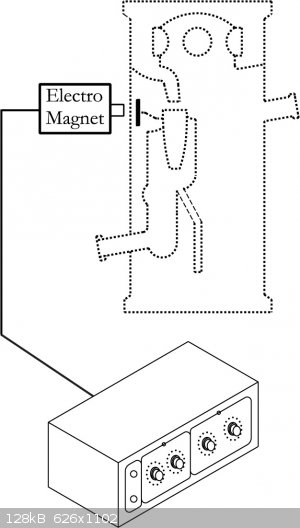
|
|
|
Druïdecook
Harmless

Posts: 13
Registered: 12-3-2016
Member Is Offline
Mood: No Mood
|
|
Ok thnx,
I can't get a good pic off it.
But the wire is silver shiny and is molded into the glass.
The exposed pieces (square) are also very shiny.
Only some fine bubbles (air) could be seen
Pt is a real possibillity i think.
|
|
|
gsd
National Hazard
   
Posts: 847
Registered: 18-8-2005
Member Is Offline
Mood: No Mood
|
|
You can check with permanent magnet whether the internal moves.
gsd
|
|
|
Druïdecook
Harmless

Posts: 13
Registered: 12-3-2016
Member Is Offline
Mood: No Mood
|
|
Ok Thnx,
I will look for a speaker to test
greets
|
|
|
unionised
International Hazard
    
Posts: 5135
Registered: 1-11-2003
Location: UK
Member Is Offline
Mood: No Mood
|
|
If you are waving a magnet around, you can see if the feedthroughs are magnetic.
Dumet is; platinum isn't.
|
|
|
Druïdecook
Harmless

Posts: 13
Registered: 12-3-2016
Member Is Offline
Mood: No Mood
|
|
Oh ok, You were talking about the electrodes 
Ok I wil try that. I assume that the wirering is the same as the square unexposed sufaces
Thnx for the clearence.
Edit: non magnetically--> Pt..
[Edited on 13-3-2016 by Druïdecook]
|
|
|
Dr.Bob
International Hazard
    
Posts: 2817
Registered: 26-1-2011
Location: USA - NC
Member Is Offline
Mood: Mildly disgruntled scientist
|
|
That is quite a load of glassware. I have a few pieces almost that complex, but you have much more complex pieces than almost anyone I have ever
seen. The jackets columns may be worth a bit, if you can find a buyer, they can run from hundreds of dollars to thousands new, so treat them gently,
they are likely valuable to someone. I have never seen a magnetic fraction diverter like that before, but neat idea.
The second set of photos has some neat ball joint glassware, I have a few pieces of ball joint (mostly S35) flasks, tubes, and fittings, plus some
adapters for them, if you need any replacements or fill in pieces. And some of the pieces look like they are tops or connectors for larger reactors.
|
|
|
Druïdecook
Harmless

Posts: 13
Registered: 12-3-2016
Member Is Offline
Mood: No Mood
|
|
Hi Dr Bob,
Youre comment makes me very excited..
I am thinking to try to get in contact with the museum's operating manager to learn more about the history of the items.
I don't have the intension to sell yet. It was the first idea but now I am trying to get the unit complete if my idea of it's application is right.
Especially the spinningband column with its encription fascinates me. The part of patent pending could suggest that it came from the creator of that
kind of spinning band column. It may add another dimension for the real glass fanatics.
I also have some simpler designed glass item's wich application is unkown to me. I will post some pics soon.
I was thinking that the 'reactor lids' also could function as a widening/ reducing section for a spiral condensing tube (begin / end). Missing in
that case is a glass pipe withe in- and outled for the coil.
Again thank you all to help withe this
[Edited on 18-3-2016 by Druïdecook]
|
|
|
| Pages:
1
2
3
4
5
6
..
16 |